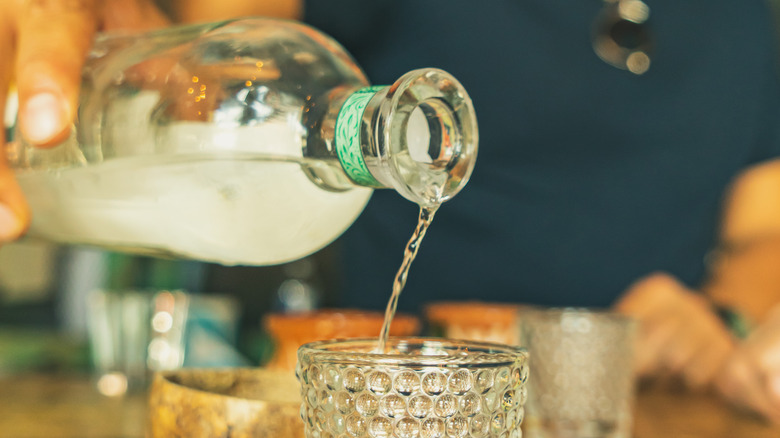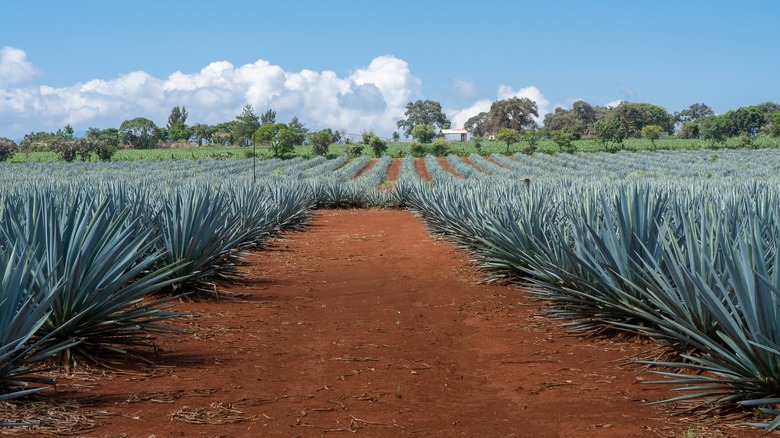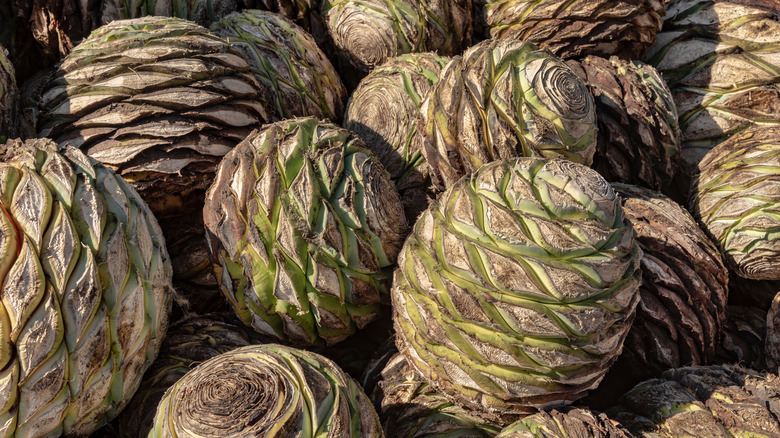The Difference Between Tequila And Mezcal
Tequila and mezcal are no doubt iconic Mexican spirits — and while most drinkers know that they're not quite the same thing, few know precisely what it is that distinguishes them. Some of the confusion likely stems from the fact that both of them are made from the agave plant, a plant species native to Mexico. Officially speaking, any liquor made from the agave plant (which has around 200 subspecies) is referred to as mezcal, so, tequila is actually a type of mezcal. However, only liquors that are made with the Blue Weber agave plant can be called tequila (plus, tequila can't use agave plants that grow in the wild, only mezcal can). This means that all tequilas are mezcals, but not all mezcals are tequilas.
It's similar to the difference between bourbon and whiskey. Bourbon is just one type of whiskey, but to earn the name "bourbon," it needs to have a mash bill that's at least 51% corn. But there's more to the tequila-mezcal conundrum than just their naming conventions; there's also a notable difference in taste between the two. Mezcal is known for being more smoky, while tequila has a sharper taste with more sweetness. And the reason for this comes down to the way each is produced.
How tequila is produced
To distill tequila and mezcal, producers use the piña of an agave plant, or the large woody core of the plant under all the leaves: It somewhat resembles a pineapple and can weigh well over 100 pounds. The Blue Weber piña has a relatively high level of sugar, which is why tequila tends to be a bit sweeter than mezcal. (That said, there can be a lot of variation between different types of mezcal, because they can be made with a far wider variety of agave plants, each with their own characteristics.)
For tequila, the piña is steamed in a brick oven, then juiced (for maximum liquid extraction, it is usually crushed or shredded beforehand) and the resulting liquid is left to ferment. After fermentation, the tequila can be bottled straight away or aged for two months: This version of tequila is usually clear, and described as either tequila joven or blanco and has a sharper flavor. Otherwise, it will be aged for an even longer period; tequila reposado is aged from two months to a year, tequila añejo for longer than a year, and extra añejo has been aged for three or more years. The more aged versions have a darker color and develop a more rounded, woody flavor from the barrels in which they rest. While aged versions are better as sipping tequilas, clear tequila is generally used for cocktails and shooters.
How mezcal is produced
To produce mezcal, the agave plant's piña is roasted (instead of steamed) in a fire-heated underground pit. The fuel for the fire can include aromatic types of wood, which instill a smoky flavor early in the process. Juice and fibers are then extracted from the roasted piña, mixed with water, and left to ferment for several days. The ferment is then distilled to reduce the amount of water and boost the alcohol level.
Mezcal can be aged similarly to tequila, and they follow the same classification system. That said, aged mezcal is not so common in comparison to tequila, and while it's possible to let it mature in wooden barrels, many purists recommend only doing so in glass. Mezcal that's been aged this way will clearly bear the label, madurado en vidrio or "aged in glass."
Because mezcal can be made with any of about 40 different agave plants, it's difficult to give a singular description of its taste — some agaves can make for a sweeter mezcal, others for a more mineral one, but in comparison to tequila, it's generally more earthy and smoky. Although mezcal has started to appear in cocktails in recent years, it's more traditional to consume it neat, perhaps with orange slices and sal de gusano (worm salt) on the side.


